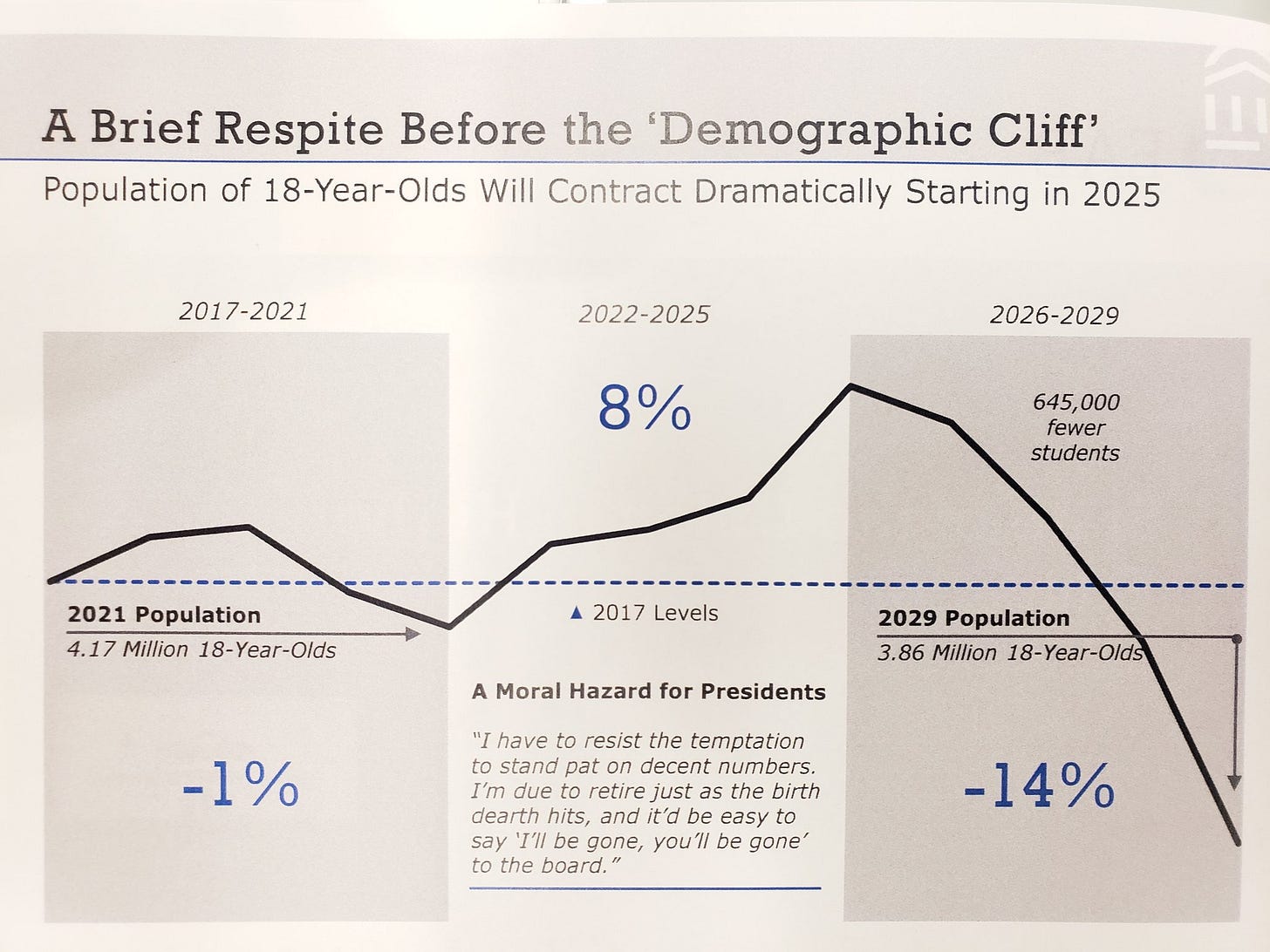Do you remember the 2007 financial crisis? I don’t.
I was in grade 9 at the time, and didn’t follow financial news. Plus, I grew up in Ottawa, which is famously a town where everybody works for the Federal Public Service, so we aren’t really impacted by cyclical macroeconomic trends.
Fertility, unlike government employment, was greatly impacted. 2007 was the high-water mark for births in the United States… and as old as this makes you feel… all of those children born in the aftermath of the 2007 crisis will turn 18 in just a couple of short years, in ~2026.
In 2014, an article in The Atlantic reported calculations that “At least a half-million fewer Americans were born as a result of the 2008 crisis … “It's not that these women are simply having babies later. The recession seems to have dampened their baby-making prospects for their entire lives.”
Note that those half-million fewer births are attributed solely to moms who were in the narrow 20 to 24 age bracket, and all prior to 2014.
If we extend this trend to mothers (birthing persons?) of all ages, and extend the timeline from 2014 to 2023, the scale is staggering. These missing births can be (very crudely) calculated by filling in the area of this shaded red triangle:

By my calculations, the area of this red triangle is 4.57 million missing children.
The current rate of college enrollments is 73%, which translates to 3.36 million missing kids who would have attended college.
The average cost of college in the United States is $35,551 per student per year.
The average student takes 6 years to earn a 4-year degree — let’s call it 5 years just to be conservative. For simplicity’s sake, we are excluding 2-year & 3-year institutions.
3.36 million students * 35,551 (assuming inflation doesn’t exist, lol) * 5 years =
$597,256,800,000 USD
This is a crude calculation meant to illustrate the general problem, but even so, that’s over half a trillion fewer dollars that will be pumped into America’s college ecosystem over the next decade. The current market size, measured by revenue, of the Colleges & Universities industry is $558.1 billion… roughly the same size.
Meaning roughly 1 out of 10 students at your university will disappear.
My crude calculations align with professional forecasts. In his books Demographics and the Demand for Higher Education and The Agile College, economist Nathan Grawe projects that over the next decade, the pool of applicants for 4-year institutions will contract by 10%.
Can your university survive a 10%-15% drop in tuition-paying students?
On a related note, Tyler Cowen expects academia to collapse in “4 or 5 years.”
Elite schools like Harvard, Princeton, Stanford etc. will be fine, since their tuition flows are a drop in the bucket compared to their endowment stock, and they will always have unlimited children champing at the bit to select from.
“I believe its gonna be two groups who come out of this. Elite colleges that can afford to continue to bring in the most qualified and exceptional students, and the publics that receive strong state support and can provide an attractive value proposition and real career training.”
In contrast to elite schools, it is widely expected that poorer Liberal Arts Colleges (LAC) will be decimated.
“Small private colleges, regional public universities, and rural institutions all face strong headwinds, according to the bond agency Fitch Ratings. The outlook, said Emily Wadhwani, senior director and sector lead for higher education at Fitch, is ‘weak getting weaker.’”
Harvard Business School Professor Clayton Christensen predicts that 50% of colleges and universities will close in the next decade.
For reference, here are some articles to that effect. The titles speak for themself:
Will Half Of All Colleges Really Close In The Next Decade? (Forbes)
A declining school-age population leaves small colleges at a crossroads
At the Edge of a Cliff, Some Colleges Are Teaming Up to Survive (NYT)
The Case of the Disappearing Liberal Arts College (Inside Higher Ed)
Programming note: I am still experimenting with where to place the paywall on my weekly Sunday article for paid-subscribers only. Today it is 25% of the way through the article; there is still 75% left. Here are the next 4 sections of this article:
Covid is Throwing Gasoline on the Fire
What Does this Mean for Professors?
What Does this Mean for Administrators?
Less People Should Attend University Anyways
Also, I am shifting this paid article from “every Sunday” to “every weekend.” I have learned that I tend to have the article ready to go by Saturday, and I tend not to have the self control to wait until Sunday to post it.
Keep reading with a 7-day free trial
Subscribe to Karlstack to keep reading this post and get 7 days of free access to the full post archives.










